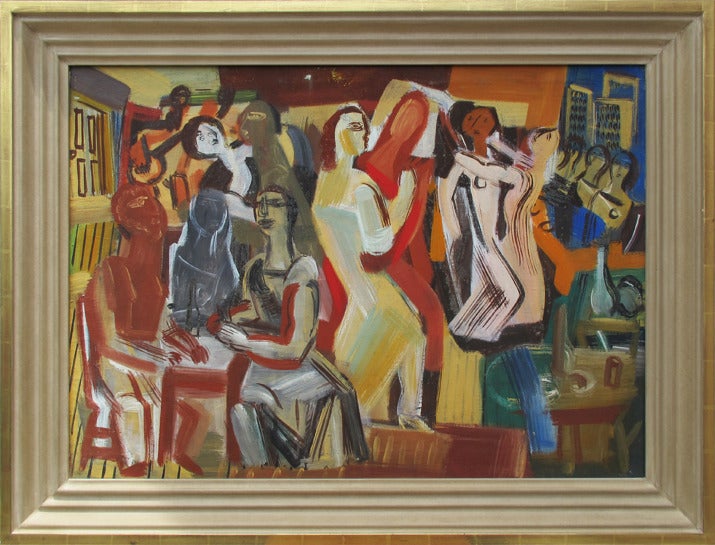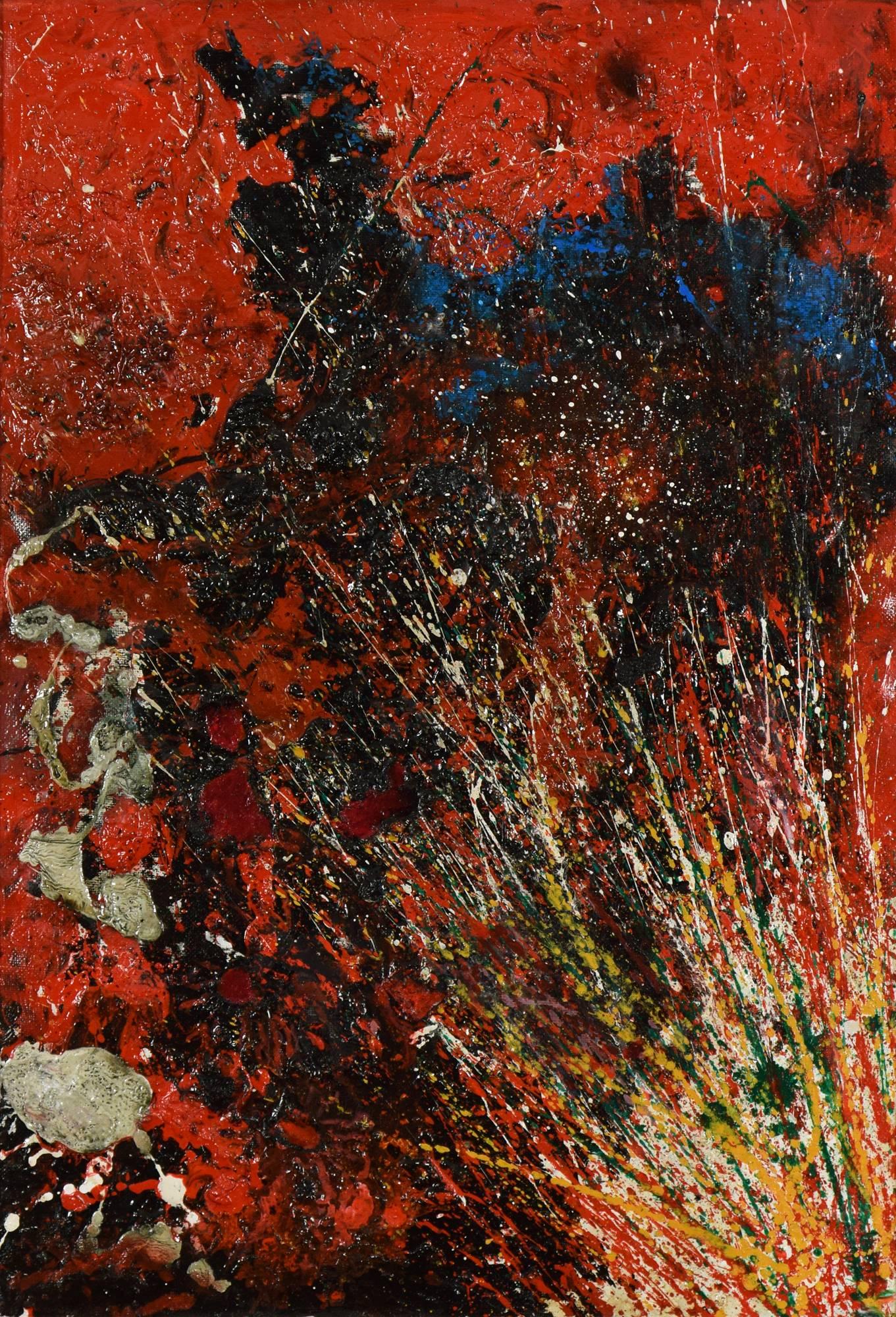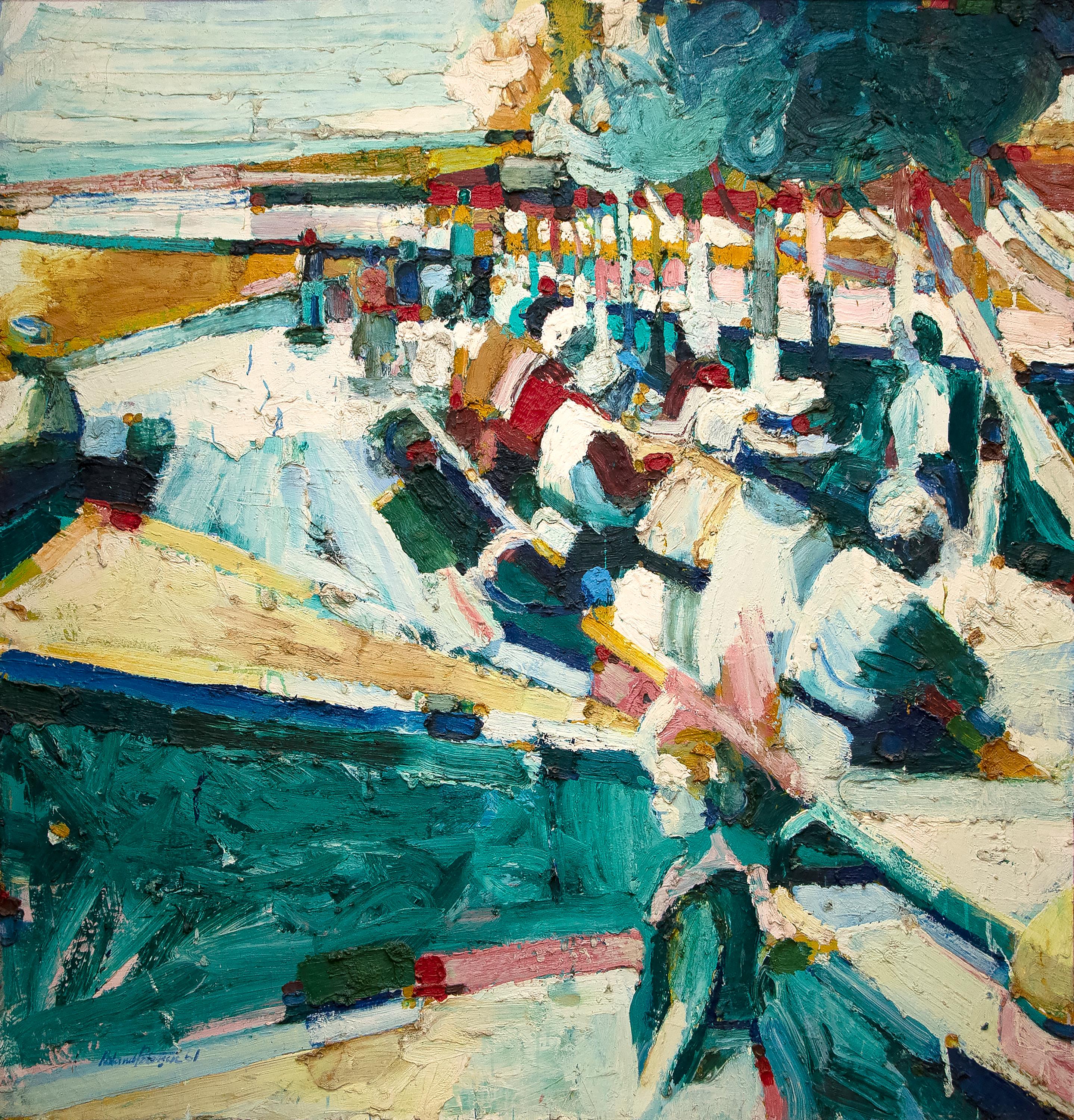Hans BurkhardtFasnacht oil painting by Hans Burkhardt1964
1964
About the Item
- Creator:Hans Burkhardt (1904 - 1994, Swiss)
- Creation Year:1964
- Dimensions:Height: 20 in (50.8 cm)Width: 24 in (60.96 cm)
- Medium:
- Movement & Style:
- Period:
- Condition:Very good condition, appropriate for the age of this artwork.
- Gallery Location:Hudson, NY
- Reference Number:
Hans Burkhardt
Hans Gustav Burkhardt was a Swiss-American abstract expressionist artist. He was born on December 20, 1904, in Basel. Burkhardt’s paintings of the 1930s are part of the genesis of American abstract expressionism. He moved to Los Angeles in 1937 and represented the most significant bridge between New York and Los Angeles. He brought with him many of the nascent ideas of abstract expressionist painting that had been swirling among New York's artists, foremost among them, Arshile Gorky and Willem de Kooning. Working independently in Los Angeles, Burkhardt's experimental investigative approach parallelled and in many instances anticipated the development of modern and contemporary art in New York and Europe. His unique role as an important American painter is affirmed by the constant interest and continuing reassessment afforded his work. In 1992, Burkhardt was honored as the recipient of the Lifetime Achievement Award by the American Academy of Arts and Letters. His works are displayed across many museums, including the British Museum, Metropolitan Museum of Art, Whitney Museum of American Art, Los Angeles Museum of Contemporary Art and Norton Simon Museum. Burkhardt died on April 22, 1994, in Los Angeles.
- ShippingRetrieving quote...Ships From: Hudson, NY
- Return PolicyThis item cannot be returned.
- Environs of a Bridge oil painting by Seymour FranksBy Seymour FranksLocated in Hudson, NYHand-signed and dated "Franks 44" lower right. This work is in its original hand painted frame, made by the artist. The frame measures 29 ½" x 35 ½" x 1 ¾" and the canvas measures 26...Category
1940s Abstract Expressionist Abstract Paintings
MaterialsCanvas, Oil
- Flowers and Tears abstract oil painting by Hans BurkhardtBy Hans BurkhardtLocated in Hudson, NYStrong abstract painting by Hans Burkhardt. Hand-signed, titled and dated "Flowers and Tears 1968 / Hans Burkhardt" verso on canvas. Provenance: The artist to his daughter Elsa. By...Category
1960s Abstract Expressionist Abstract Paintings
MaterialsCanvas, Oil
- #2 (5) Abstract Oil Painting by Max SchnitzlerLocated in Hudson, NYThis painting measures 55 ¾" x 35 ½" and framed 57" x 37" x 1". It is hand-signed "Schnitzler" on the lower right. About this artist: Max Schnitzler (1903-1999) emigrated with his ...Category
Mid-20th Century Abstract Expressionist Abstract Paintings
MaterialsCanvas, Oil
- 4-35 abstract oil painting by Charles BiedermanLocated in Hudson, NYSigned and dated "Biederman 4-35" lower right. About this artist: Charles Joseph Biederman was a twentieth century abstract American artist best known for his constructivist, cubist...Category
1930s Abstract Expressionist Abstract Paintings
MaterialsCanvas, Oil
- Deep as the Night, an oil painting by John Von WichtBy John von WichtLocated in Hudson, NYThis work is one of a group of over 100 works personally selected by the artist, and gifted to a close personal friend in 1969. Exhibited: 1967 National Academy Annual Exhibition -...Category
1960s Abstract Expressionist Abstract Paintings
MaterialsCanvas, Oil
- Abstracted pair of oil paintings by Carl HoltyBy Carl HoltyLocated in Hudson, NYThese artworks by Carl Holty are only sold as a pair. Each painting measures 9" x 11" and framed 18" x 20.25" x 2.5" The red and gold work is signed "Carl Holty" in the lower right. About this artists: Carl Holty was awakened to his interest in art as a child through visits to the Layton Art Gallery of Milwaukee, and began painting lessons with Friedrich Wilhelm Heine at a young age. Though born in Freiburg, Germany, in 1900, he was raised in Wisconsin and enrolled at Marquette University. Before long, Holty abandoned his pre-medical studies in order to pursue art. He spent a summer at the School of the Chicago Art Institute in Saugatuck, Michigan, and set off for New York in 1920. He then studied at the National Academy of Design under Francis Coates Jones...Category
1940s Abstract Expressionist Abstract Paintings
MaterialsCanvas, Oil
- Diving for PearlsLocated in New York, NYDiving for Pearls, 1986 Oil on canvas 88 x 76 in. (223.5 x 193 cm) Signed, dated, and titled, versoCategory
1980s Abstract Expressionist Abstract Paintings
MaterialsCanvas, Oil
- James Joyce's SmileLocated in New York, NYJames Joyce's Smile, 1984 Oil on canvas 66 x 87 in. (167.6 x 221 cm) Signed, dated, and titled, versoCategory
1980s Abstract Expressionist Abstract Paintings
MaterialsCanvas, Oil
- Large Scale Mid-Century Earth-tone Horizontal Abstract by Joseph VasicaBy Joseph VasicaLocated in Soquel, CALarge Scale Mid-Century Earth-tone Horizontal Abstract by Joseph Vasica Very large scale (70"H x 160"W) (5.8'H x 13.3'L) mid-century abstract with soft edge, grey and burnt sienna...Category
Mid-20th Century Abstract Expressionist Abstract Paintings
MaterialsCanvas, Oil
- "Manhattan Night Life"By Vaclav VytlacilLocated in Lambertville, NJJim’s of Lambertville is proud to offer this artwork by: Vaclav Vytlacil (1892-1984) He was born to Czechoslovakian parents in 1892 in New York City. Living in Chicago as a youth, he took classes at the School of the Art Institute of Chicago, returning to New York when he was 20. From 1913 to 1916, he enjoyed a scholarship from the Art Students League, and worked with John C. Johansen (a portraitist whose expressive style resembled that of John Singer Sargent), and Anders Zorn. He accepted a teaching position at the Minneapolis School of Art in 1916, remaining there until 1921. This enabled him to travel to Europe to study Cézanne’s paintings and works of the Old Masters. He traveled to Paris, Prague, Dresden, Berlin, and Munich seeking the works of Titian, Cranach, Rembrandt, Veronese, and Holbein, which gave him new perspective. Vytlacil studied at the Royal Academy of Art in Munich, settling there in 1921. Fellow students were Ernest Thurn and Worth Ryder, who introduced him to famous abstractionist Hans Hofmann. He worked with Hofmann from about 1922 to 1926, as a student and teaching assistant. During the summer of 1928, after returning to the United States, Vytlacil gave lectures at the University of California, Berkeley, on modern European art. Soon thereafter, he became a member of the Art Students League faculty. After one year, he returned to Europe and successfully persuaded Hofmann to teach at the League as well. He spent about six years in Europe, studying the works of Matisse, Picasso, and Dufy. In 1935, he returned to New York and became a co-founder of the American Abstract Artists group in 1936. He later had teaching posts at Queens College in New York; the College of Arts and Crafts in Oakland, California; Black Mountain College in North Carolina; and the Art Students League. His paintings exhibit a clear inclination toward modernism. His still lives and interiors from the 1920s indicate an understanding of the art of Cézanne. In the 1930s, his works displayed two very different kinds of art at the same time. His cityscapes and landscapes combine Cubist-inspired spatial concerns with an expressionistic approach to line and color. Vytlacil also used old wood, metal, cork, and string in constructions, influenced by his friend and former student, Rupert Turnbull. He eventually ceased creating constructions as he considered them too limiting. The spatial challenges of painting were still his preference. During the 1940s and 1950s, his works indicated a sense of spontaneity not felt in his earlier work. He married Elizabeth Foster in Florence, Italy, in 1927 and they lived and worked in Positano, Italy for extended periods of time. Later on, they divided their time between homes in Sparkill, New York and Chilmark, Massachusetts, where Vyt, as he was affectionately called, taught at the Martha's Vineyard Art...Category
1930s Abstract Expressionist Abstract Paintings
MaterialsCanvas, Oil
- Red Composition by TOSHIMITSU ÏMAI - Contemporary, Abstract, Oil on canvasBy Toshimitsu ImaiLocated in London, GB*PLEASE NOTE UK BUYERS WILL ONLY PAY 5% VAT ON THIS PURCHASE. Red Composition by TOSHIMITSU ÏMAI (1928-2002) Oil on canvas 80.2 x 55.3 (31 ⅝ x 21 ¾ inches) Signed, TOSHIMITSU IMAÏ, dated, 1963 Paris and inscribed in Japanese on the reverse Provenance Private collection, USA Born in Kyoto, Japan in 1928 Imai was part of the 20th century Japanese avant-garde. He began his formal education at the Tokyo State Art Academy where he took up painting. His early works are characterised by colourful abstractions, reminiscent of Favuism. In 1951 Imai was awarded the Kansai-Shinseisaku Prize and in 1952 the prize for the best new artist at the 15th Shinseisaku Salon. Imai relocated to Paris in 1953, the same and subsequent year he exhibited at the Salon de L’Art Sacré. Meanwhile, he attended the Académie de la Grande Chaumière and the Sorbonne to read medieval history and philosophy. In 1955, Imai completely abandoned representational art in favour of abstraction. After meeting the art critic Michel Tapié via the artist Sam Francis, Imai was the first Japanese artist to join the Art Informel movement. In 1956 Imai was called upon by the Japanese artist Taro Okamoto to curate an exhibition entitled The World: Today’s Art in Tokyo. Artists such as Jean Dubuffet, Jean Fautrier, Lucio Fontana, and Karel Appel gained important exposure in Japan. It was also in 1957, when Imai arranged for Tapié and the artists Georges Mathieu and Sam Francis to travel to Japan, that a connection between Art Informel and Gutai occurred. The Ashiya-based Gutai Art Association formed in 1954 was proclaimed a kindred spirit by Tapié which he subsequently promoted internationally. Founding members included Yoshihara Jiro, Kanayma Akira, Murakami Saburo, Shiraga Kazuo and Shozo Shimamoto...Category
1960s Abstract Expressionist Abstract Paintings
MaterialsCanvas, Oil
- UntitledBy Roland PetersenLocated in Palm Desert, CAA painting by Roland Petersen. This Untitled, oil on canvas, abstract painting is executed in thick and lush impasto, in colors primarily of greens, blues, teals, white, red, ochre a...Category
1960s Abstract Expressionist Abstract Paintings
MaterialsCanvas, Oil






